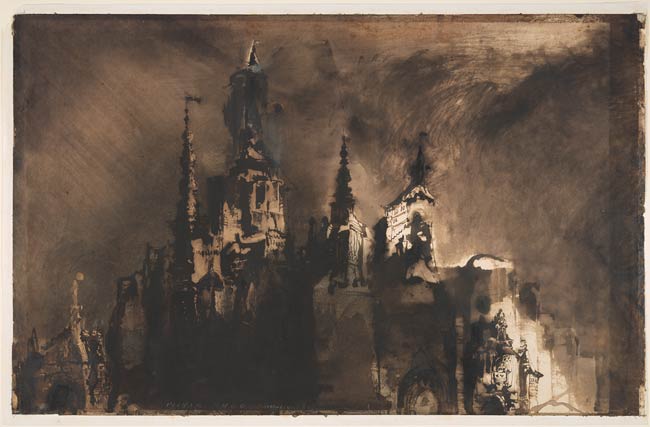
After delivering an impassioned speech against Louis Bonaparte and publishing Quatorze discours, a volume of political writings in 1851, Hugo found his position in France precarious. Having participated in the coup d'état of 2 December 1852, at the end of the year, he fled Paris for Brussels, where Bonaparte later expelled him. Hugo then moved to Jersey, which he was forced to leave in 1855 because of his acts of political agitation. The remainder of his exile was spent in Guernsey, although he traveled frequently to Brussels and abroad. On 5 September 1870, the day following the founding of the Third Republic, he returned to France with his family.
During his first few years in Guernsey, occupied with the decoration of his new home, Hauteville House, Hugo was more active as a draftsman than a writer. The rough, extreme setting of the Channel Islands fostered dramatic and violent imagery in his work and the author's meditations on nature, death, and the sublime. He wrote to his friend, the literary critic Abel-François Villemain (1790-1870), from Hauteville House on 17 November 1859, “I need these periods of rest sometimes in my solitude, in face of the ocean, amid this sombre scenery which has a supreme attraction for me and which draws me toward the dazzling apparitions of the infinite. Sometimes I spend the whole night meditating on my fate, before the great deep, and at times all I can do is exclaim: 'Stars! stars! stars!'”
Hugo began drawing in 1831; however, it was not until 1848 that he developed the wash technique, incorporating stencils and other media, which characterized his mature style. The castle motif is found throughout his texts and drawings, although many of his depictions are reminiscent of castles he visited during his travels to the Continent. These structures are fundamentally works of the imagination, assuming their final form only during creation. In this large, dramatic sheet, he masterfully utilized many techniques with which he began experimenting in Jersey. Hugo used a stencil to mask the silhouette of the château; the white reserves of paper provide a luminous contrast to the rich, fluid ink taches. After broadly applying the wash, he dipped his pen in the pools of ink to quickly draw out delicate architectural details, causing forms to coalesce from the chiaroscuro of the inky background. Several sheets representing similar structures, also dated Guernsey 1857, reveal Hugo's experimentation with the castle motif at that time.
Signed, inscribed, and dated in white gouache at lower center, VICTOR HUGO-Guernsey. 1857.
Watermark: none.
Thaw, Eugene Victor, former owner.
Thaw, Clare, former owner.
The Morgan Library & Museum, New York, NY, "Drawn to Greatness: Master Drawings from the Thaw Collection", 2017. Exh. cat., no. 199, repr.
The Thaw Collection : Master Drawings and Oil Sketches : Acquisitions since 1994. New York : Pierpont Morgan Library, 2002, no. 37.
100 Master drawings from the Morgan Library & Museum. München : Hirmer, 2008, no. 83, repr. [Jennifer Tonkovich]
